Université du SI day 2: Heroes
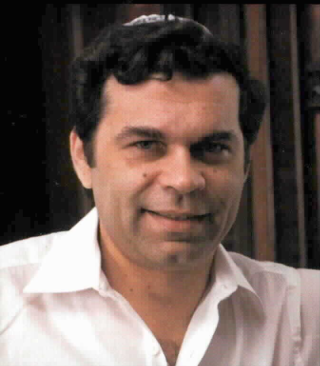 We start the day with a refreshing run up the Champs Elysées, down to the Eiffel tower and along the Seine. I’ve been looking forward to this day: I will meet two of my heroes!
We start the day with a refreshing run up the Champs Elysées, down to the Eiffel tower and along the Seine. I’ve been looking forward to this day: I will meet two of my heroes!
Eli Goldratt challenges us throughout the whole keynote. Do we want an easy life or a meaningful life? We have in our hands the most powerful tool that has ever been invented and what have we done with it? Have we brought enormous value to companies and people? We haven’t: we’ve automated the same old processes; we’ve looked no further than local optima; we’ve enabled people to perform useless work faster than ever before. Is that all we want to achieve?
What is the greatest challenge businesses face? The ability to take the right decisions at the right time. IT is the ideal tool to support that decision-making, at all levels of the company: we can store, transfer and manipulate prodigious amounts of data almost instantly. We can provide the Information people need to make decisions. We can create an enormous amount of value, but by all accounts (sic) we haven’t.
Why haven’t we fulfilled the promise of IT? The tools are out there: Theory of Constraints, Lean, the Thinking Processes, Agile… Most of them readily available and only a few clicks away. Why haven’t we used those tools? One of the reasons is that we would have to step out of our comfort zone. We need to stop dabbling with technology and look further, to accounting, sales, marketing and production. We need to see the whole system and realize its goal. Do we want an easy life or a meaningful life? Do we want to ‘fulfill requirements’ or do we want to add value? Who dares to enter into a contract with a customer where payment depends on value added?
Where are the real constraints?
The real constraints are in (implicit) rules. Who has the intelligence to recognize those rules and the guts to challenge them? Common Action (“that’s how we’ve always done it”) is not the same as common sense. Accounting rules and the way we measure are some of the most pernicious constraints. We have the tools and the obligation to change the system, to enable our companies and people to realize their full potential.
People do not resist change, according to Goldratt. People resist changes that are unclear, that threaten them, that might harm them or that bring no clear value to them. Resistance is your cue to realize that your proposal is not fully worked out and that your explanation is not clear.
Goldratt’s call to arms can be summarized as: “Get of your asses and start using your brains!” I thought this was an excellent, inspiring and thought-provoking keynote. I left the auditorium with a renewed resolve to create meaning and value.
Lean
We participated in an excellent exercise led by Olivier Pizzato and Christian Daniel about using Lean techniques to solve IT project challenges. We worked in small groups on different scenarios. For each scenario we defined three approaches to solve the problem; listed the three biggest obstacles/objections to the most promising approach; searched for a way to overcome the biggest obstacle. After a group presented their analysis, Christian linked the solution back to Lean principles and techniques.
What I like about the session are the exercises and the short (15 min) timeboxes. To make this session perfect I would provide participants with more structure and guidance about Lean, so that they can apply the techniques to the exercises.
We attend part of the session about how Google will revolutionize the development of IT systems. Bernard Notarianni and Didier Girard pair-presented the session in a very relaxed style. Portia thought it looked like a French game show. The session gave examples of web design principles that can be applied to internal IT systems. The resulting systems, often using a RESTful style, are simple and easy to integrate. We had to leave before the end to prepare for our next run of the Bottleneck Game.
Goulots d’étranglement, take three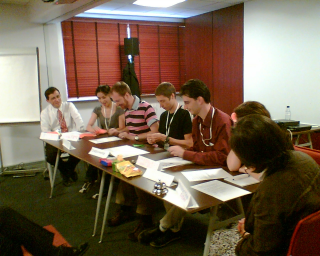
After Goldratt’s keynote interest for our session is very high, the room is packed full. Seven volunteers come forward to play the role of the “workers”; the other participants are the “consultants” who observe and give improvement tips to the workers. They all get paid in Belgian chocolates and British sweets.
After one round of play we go through the “5 focusing steps”:
0. Define the goal of the system
1. Find the bottleneck
2. Exploit the bottleneck, get the most value out of the constrained resource
3. Subordinate all decisions to the bottleneck
4. Elevate the bottleneck when it has been exploited fully and all decisions have been subordinated
5. GOTO 0. Don’t let inertia become the constraint
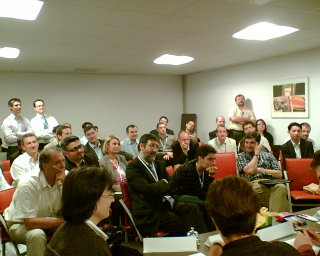
The team makes some improvements to their process and plays a second round. The decision to subordinate to the bottleneck wasn’t fully implemented. The team had planned to put a buffer of work in progress before the bottleneck. They failed to keep it filled, which led to an idle bottleneck and reduced output of the system. The players used their idle time to ‘learn’ so that they could help the bottleneck in the next round.
Changing the system, breaking through constraints
Warning: don’t read this section if you want to play the game with an open mind!
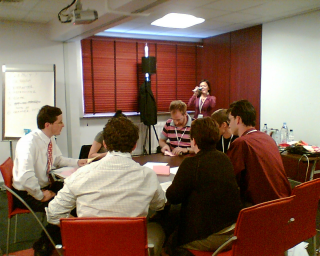
The game is filled with arbitrary constraints:
- players are very specialized and can’t help each other
- the two customer representatives sit far apart
- the layout of the table makes it difficult to get an overview and to communicate with the other team members
- testing is done at the end. Nobody but the tester knows the acceptance tests
In the third round we make the players think about the assumptions and rules built into the game. They get to change their system. The most powerful thing they can do is to re-arrange the tables. As you can see in the picture, the team has a better oversight and can communicate more easily when they sit around the tables.
In the end, this team didn’t produce as much as the previous team on the first day of the Université du SI. I think this is because this team tried to be too sophisticated. Instead of simply implementing an optimisation as agreed, they kept discussing and tweaking their way of working. The DO part of Plan-Do-Check-Act shouldn’t be skipped.
Running this session in 90 minutes is exhausting. Time for a break before the closing keynote.
Man from the moon
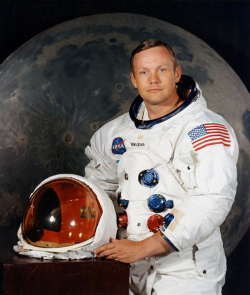 OCTO brought Neil Armstrong to Paris for the closing keynote. As a little kid I read a lot of science fiction, fascinated by the tales of wonder and limitless possibilities. I devoured everything about the “Space Race”. These people were making science fiction a reality. By the time I was old enough to understand what was happening, the space race was already over; interest for space exploration was gone. We had stopped looking outward.
OCTO brought Neil Armstrong to Paris for the closing keynote. As a little kid I read a lot of science fiction, fascinated by the tales of wonder and limitless possibilities. I devoured everything about the “Space Race”. These people were making science fiction a reality. By the time I was old enough to understand what was happening, the space race was already over; interest for space exploration was gone. We had stopped looking outward.
Armstrong’s keynote was humorous, enthralling and humble. These teams achieved wonders with the technology of that day (e.g. on-board computers with a few K of memory) and took enormous risks. The American and Russian space programs are a testament to what we can achieve if we really set our mind to it.
I was thoroughly inspired by these two keynotes by my heroes. Armstrong showed us what we can achieve; Goldratt exhorted us to achieve our potential, starting NOW.
The end. Or the beginning?
The conference is over. Our visit to Paris is over. Thank you to Octo for organizing this conference and for inviting Portia and me. We left Paris buzzing with ideas and energy.